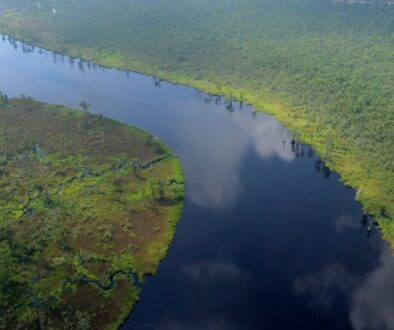US politics complicates bid to protect nature
It’s been a month since the United Nations Biodiversity Conference (COP15) ended with a historic international agreement aimed at expanding efforts to protect and preserve land, water and ecosystems around the globe.
Now the more than 190 countries that approved the ambitious plan to protect 30% of the planet’s land and oceans by 2030 – among other goals- are faced with how to turn their promises into political realities.
In the United States, efforts to counteract the extinction crisis must contend with a unique set of challenges. Not only did the US sit on the sidelines at COP15, declining to join in the agreement, but newly strengthened Republican forces in Congress signal that progress on protecting nature won’t come easy.
Last year, Republican congressmembers introduced the “30 x 30 Termination Act,” which would overturn a Biden Administration’s conservation plan very similar to a target in the Global Biodiversity Framework adopted at COP15. Republicans call the plan a “land grab.”
Though the act has so far failed to pass, congresswoman Lauren Boebert of Colorado plans to reintroduce it now that Republicans control the US House of Representatives.
The situation at the federal level has environmental advocates worried and ramping up their own conservation efforts to confront the extinction crisis.
“We’re not playing at the international level and we’re not taking [the extinction crisis] seriously on our own soil,” said Tierra Curry, a senior scientist at the Center for Biological Diversity.
Federal shortcomings
US spending to support biodiversity conservation in developing countries, which amounted to about $319 million in 2021, is “barely even a drop in the bucket, especially since US consumers play a disproportionate role in global climate and biodiversity impacts,” according to Curry.
Another problem is the fact that the US omnibus spending package, which passed as COP15 came to a close, includes measures that prohibit the US Fish and Wildlife Service from protecting the Greater Sage-Grouse under the Endangered Species Act and delays protections for North Atlantic right whales, Curry said.
At the same time, a major bill to fund species conservation, the Recovering America’s Wildlife Act (RAWA), was cut from the spending package at the last moment.
Last year, the US did commit to increase its contribution to the Global Environmental Facility, a fund to support environmental projects in developing countries. But Nav Dayanand, an associate director of legislative affairs at The Nature Conservancy, said most other forms of assistance the US provides to help developing countries meet their environmental goals have flatlined.
“[These financial contributions are] strong and stable, which is a good sign, but they aren’t at the level that we would love to see,” said Dayanand. “We need, really, a quadrupling of investments to help address the biodiversity and climate crises.”
While US conservation leadership – both at home and on an international scale – may have notable weaknesses, Dayanand pointed to the US’ America the Beautiful initiative, the US 30 x 30 plan that launched in 2021, as a major strength.
“One of Biden’s early actions was to commit the administration to design strategies to conserve at least 30% of lands and waters in the US by 2030,” said Dayanand. “We believe that the [Global Biodiversity Framework] that was adopted at COP15 follows on that US strong commitment and investment.”
Political shake-up
Even under a new Congress with a Republican-led House, Dayanand thinks the US government will continue supporting environmental progress, at least on an international level.
“There are ways in which we think that we can still continue to inspire and help secure strong support in the Congress for global environmental commitments,” said Dayanand. “We think new leadership might appreciate how investment globally connects back to US interests, both economic and security interests. [And] we have seen strong bipartisan support, for example biodiversity programming at USAID, for a long time.”
But Rosalind Helfand, and environmental consultant and co-founder of the California Global Biodiversity Working Group, worries the political shake-up may impede progress on environmental work at home.
“I think it’s tough when you’re going to have to be constantly working uphill with your national leadership and I think that’s a challenge from our new Congress,” said Helfand. “The new House’s majority is not supportive, overall, of environmentally ambitious regulations and actions. Instead of moving forward and acting in a larger environment where we have the full support of our Congress, we now have to work with a majority Congress that is potentially hostile to biodiversity action.”
“One of the most heartening things we can see despite the changes in Congress is that we have people at the neighborhood level in California who are fighting for California to take global leadership,” she added.
Moving the needle
Helfand attended COP15 with California’s delegation to the conference, where California leaders signed an agreement with Quebec to commit to a biodiversity partnership and joined a coalition to garner international support for 30 x 30 agreements.
“California took a really, really strong role at COP15,” said Helfand. “There was a huge amount of exchange between subnational governments worldwide. I think there’s a feeling in the room that potentially more can be done by subnational governments and cities in terms of really moving the needle, perhaps, than a lot of countries that are kind of stuck right now.”
Jennifer Norris, Deputy Secretary for Biodiversity and Habitat at the California Natural Resources Agency, touts California’s own 30 x 30 initiative as one of its greatest strengths as a conservation powerhouse.
“We have one of the most comprehensive and strategic visions for how to implement 30 x 30 anywhere,” said Norris. “We’re off and running on implementing that plan and there have been historic investments in the work.”
She explained that the initiative, which became the first state-level 30 x 30 strategy in 2020, focuses on protecting habitat for species across California and emphasizes activities that can contribute to biodiversity in other spaces, such as sustainable farming practices. The effort also emphasizes connecting habitats so that species can move safely between protected areas, addressing genetic isolation in threatened species.
Democratizing conservation
Norris noted that the initiative resulted from a huge degree of public engagement, with thousands of people across the state, including representatives from over 70 tribes, participating in workshops and offering feedback during its development.
As the initiative continues to progress, Norris expects much of the action to unfold at a local level. To help “democratize conservation planning across the state,” her agency partnered with a global software company to create an online mapping tool that shows the locations of biodiversity hotspots, rare plants, and freshwater streams, overlaid with climate projections, across California.
“You can game out where the conserved areas are in your region and try to identify landscape-scale blocks that you can protect,” said Norris.
“[California has] modeled an inclusive approach that’s really ground-up oriented towards getting organizations and communities inclusively on board with 30 x 30 as opposed to simply mandating it,” said Helfand. “I think that, potentially, a lot of subnational governments and countries will be looking to see how is California doing it.”
Several states have begun following California’s lead. New Mexico and New York have both passed their own 30 x 30 legislation, while Hawaii recently launched a marine initiative to protect its waters.
When it comes to whether the new power structure in Congress could jeopardize California’s conservation goals, Norris said she isn’t especially concerned.
“A lot of what we are doing is being driven by California itself and we’re full steam ahead,” she said.
Tribal power
While many US tribes don’t think the America the Beautiful initiative goes far enough, these communities can play a major role in meeting the national conservation goal, said Erik Stegman, CEO of Native Americans in Philanthropy, an organization that promotes investment in Native American communities.
“We’ve obviously been stewarding and protecting our lands and waterways for generations and we have a lot of really important legal tools at our fingertips to get this done,” said Stegman.
“I think a lot of the public doesn’t fully understand that tribes are very sophisticated when it comes to their land and water management,” he added. “We have inter-tribal fish commissions. A lot of the tribes have more biologists on staff than the states.”
Tribes are already actively engaging in US landscape-level conservation. In November, the National Fish and Wildlife Foundation awarded over $26 million in funds to tribal nations for ecosystem restoration projects – about one-third of total funds granted through a public-private grant program to support America the Beautiful.
Stegman said some of the biggest opportunities for tribes to leverage their unique expertise is through co-management arrangements between tribal communities and the federal government. For example, in 2021 the Department of the Interior transferred the National Bison Range, an 18,800-acre nature reserve, back to the Confederated Salish and Kootenai Tribes, restoring a significant portion of their homeland.
“With the bison reserve, we are looking to restore grasslands and species that have always been there, but also are integral to our own economies and our cultural lifeways,” said Stegman.
In November, the Department of Interior announced a new Office of Strategic Partnerships, which Stegman said will support joint efforts between tribes and government agencies, with a heavy focus on advancing 30 x 30.
“One of the things [the Biden administration] has done more successfully than I’ve seen in the past is these public-private partnerships,” said Stegman. “The government [alone] can only do so much.”
 EWG
EWG


